1920

1922

Following a Saskatchewan Medical Association resolution endorsing establishment of a radium institute, President Walter Murray writes to Saskatchewan Premier Charles Dunning, offering the expertise and facilities of USask for radium treatment of cancer. Dunning replied that tuberculosis was a greater health priority; and that “the possibility of successful use of radiation in any large way in the treatment of disease has not been fully demonstrated.”
“If at any time it is deemed wise to erect in the Province a radium institute for the treatment of cancer patients, it could be done at the University or elsewhere … I think there is no doubt that the University is the proper place to handle the radium.”
– President Walter Murray, 1922
1928

Prof. Ertle Harrington introduces class in medical physics, an innovation at the time. “Particular attention will be paid to the physical basis underlying those applications of physics which are of special importance and interest to students and practitioners of medicine.”
1929

Saskatchewan Medical Association establishes committee to provide advice to government about cancer therapy; Prof. Ertle Harrington only non-medical member of committee.
1931
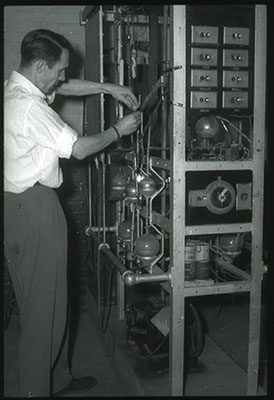
Following establishment of Saskatchewan Cancer Commission in 1930 (the first cancer control agency in Canada), first radon plant in Western Canada designed and constructed by Ertle Harrington. Housed at the physics department, provided radium seeds for cancer clinics in Saskatchewan and across Western Canada until 1962.
“Dr. E.L. Harrington … had a special genius for the construction of physical apparatus. … He built the first radon plant in Western Canada, at the request of the Saskatchewan Cancer Commission, and exercising his unusual skill as a glass-blower constructed himself all the extensive glass units required, including many novel features which added to the efficiency of the plant.”
– Carlyle King, The First Fifty: Teaching, Research and Public Service at the University of Saskatchewan, 1909-1959 (Toronto: McClelland and Stewart, 1959).
1945

Harold Johns jointly appointed to the USask physics department and the Saskatchewan Cancer Commission; supervised radium and X-ray therapy equipment for Saskatchewan’s two cancer clinics, becoming Canada’s “first full-time cancer physicist.” He came to be known as “the father of medical physics in Canada.”
“Dr. Johns took great strides in the fight against cancer. He invented and developed the Cobalt-60 machine which had an immediate impact on the cancer survival rate. Prior to the Cobalt-60, cancer therapy through radiation could only get to superficial tumors, but now this treatment could treat tumors that were deep-set and difficult to access.”
– Canadian Medical Hall of Fame, Citation for posthumous induction of Dr. Harold Johns, 1998.
''My father's life was very busy. He worked night and day. There were visitors from all over the world. The phone rang at all hours of the day and night, so we were very aware that something very important was taking place.''
- Gwen Greenstock, daughter of Harold Johns, inventor of the cobalt-60 unit; in a 1994 CBC interview
1946

Johns and Blair then visit Premier Tommy Douglas without an appointment to seek permission to purchase a betatron (a high-energy accelerator) to treat cancer patients. Douglas gives them “virtual carte blanche to proceed – without consulting his cabinet, the university, or even medical experts.”
“Well, it was easy. I had complete confidence in the knowledge and integrity possessed by both men. They assured me that high voltage radiotherapy offered great promise in the treatment of cancer. Dr. Allan Blair had come from Toronto to head up the leading cancer agency in North America. And Harold Johns!
“Why, when I attended Brandon College, [his father] was my mathematics teacher and my favorite professor. … So, with close personal knowledge of both men and my complete faith in their integrity, my permission did not seem to me to be a gamble at all.”
- Former Premier Tommy Douglas, on why he gave virtual “carte blanche” for the purchase of the betatron, as related to Stuart Houston. Quoted in Steps on the Road to Medicare and Tommy’s Team.
1948

In May, Harold Johns, Robert Haslam and Leon Katz travel to Milwaukee to inspect the betatron that had been built for Saskatchewan.
In August, University of Saskatchewan installs first betatron in Canada, located in Physics Annex—the world’s first betatron used for a cancer treatment program.
1949

After six or seven months of calibration, first patient receives cancer therapy using the betatron, on 29 March 1949 – beginning the world’s first “concerted” clinical use of the betatron.
“One patient, a seventy-one-year-old shoemaker from Prince Albert, had a deep-seated tumour in his bowels, pushing against his spine…Each day for four days, they repeated the procedure: the patient was brought from the cancer clinic to the back door of the physics department building; down the steps and around the corner to the betatron room; laid down on the treatment bed; placed in the precise position required for best treatment, using a new position each time to allow the radiation to attack the tumour from all angles; then left alone with the ugly, squat, loud machine as it whirred electrons around the doughnut and sent them deep into his body.
No improvement at first. But on the fifth day, something happened. The knot of cancer entangling his bowels and pushing on his spine released. He could feel it. For the first time in months, the patient could stand straighter, walk more easily.” (Merle Massie, A Radiant Life, p. 55-56.)
As a result, University of Saskatchewan team is recognized as world’s leading experts in calibration of betatrons.
“This was an initiative that was taken on by Atomic Energy of Canada to commercially build a (cobalt) unit. Dr. Johns wanted to build his own unit and beat the fellas to the job, beat the other out.”
– Sylvia Fedoruk, USask interview, November 2011
1951
World’s first calibrated Cobalt-60 cancer therapy unit established at the University of Saskatchewan; installed at University Hospital (G Wing) as construction continued. The calibration work was done by Sylvia Fedoruk through rigorous depth dose measurements (the subject of her M.A. thesis).
After 11 weeks of calibration, world’s first patient treated on 8 November 1951. Cured of her apparently incurable cancer, she would live to the age of 90, forty-seven years later.
https://scaa.sk.ca/gallery/uofs_events/articles/1951.php
The Saskatoon Star-Phoenix runs an editorial on March 7th, 1951 entitled The Cobalt "Bomb".
“We hope Messrs. Truman, Stalin, Peron et al won’t think someone is trying to steal their thunder, but we think they ought to know theirs is not the only atomic race going on in the world. Another has been declared by the London Free Press which claims editorially ‘the world’s first cobalt bomb for … the Ontario city.
“With all due respect to the preservation of national peace and goodwill, that is a boast which this newspaper cannot allow to go unchallenged – especially since the Free Press is brazen enough to remark that a cobalt bomb ‘is also being installed at Saskatoon, Sask.’ One is indeed. Or, to be more accurate, one has been installed.”
– Saskatoon Star-Phoenix, editorial, 7 November 1951 (quoted in Steps on the Road to Medicare, p. 120)


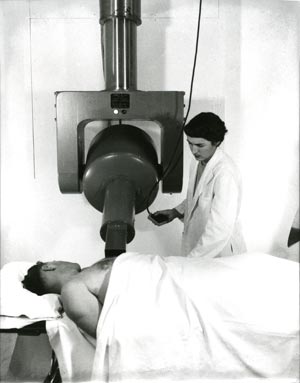
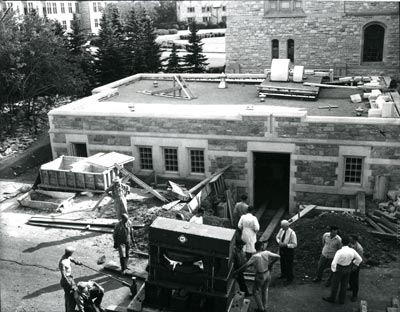
Betatron Building constructed next to Physics Building; betatron relocated.
First publication on cobalt unit measurements appears in the prestigious journal Nature, by Harold Johns, Lloyd Bates, Ed Epp, Douglas Cormack, Sylvia Fedoruk (all from Saskatchewan), with three USask physics graduates A. Morrison, W.R. Dixon and C. Garrett working at the National Research Council in Ottawa.
“The most notable accomplishment was a table of X-ray dosage rates at various depths in human tissues, ranging from x-radiation by conventional hospital machines to those by the cobalt 60 unit and the betatron. It was accepted by the British Institute of Radiology as the standard reference table for radiation dosimetry. It is still basic to all subsequent dosage tables.”
– Balfour Currie, USask physics department 1910-1976
1952

Maclean’s magazine runs a story on USask's cobalt unit with headline “The Atom Bomb That Saves Lives”, picking up on earlier references to “the cobalt bomb.”
1953
The first of four editions of The Physics of Radiation Therapy, by Harold Johns, is published – for two decades (in later editions under the title The Physics of Radiology) the world’s foremost text of medical radiation physics, translated into Spanish, Russian and Chinese


1955

Official opening of the University Hospital, the new home of the Saskatoon Cancer Clinic.
1962
First whole-body rectilinear scanner—an imaging device which captures emissions from radiopharmaceuticals—in Canada.
The University of Saskatchewan’s cancer research group, which included Sylvia Fedoruk, was moving toward earlier and more sophisticated detection of cancer in the body, to better target and refine treatment. They turned their research focus to radioisotope injections, scanners and building new equipment to ‘see’ into the body.
“The new whole-body (moving) rectilinear scanner once again required the machinist skills of Johnny MacKay of Acme Machine and Electric in Saskatoon….Between the moving scanner head and the moving bed, the two mimicked furrows in a field, taking measurements in a methodical, preset graph.” (Merle Massie, A Radiant Life, p. 117-118.)

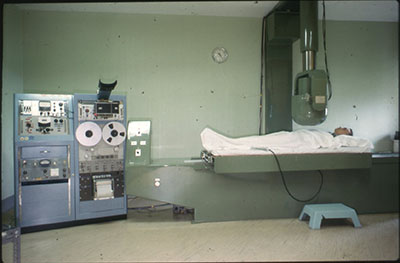
1964

The Linear Accelerator Laboratory is opened on campus under the leadership of Leon Katz. Later called Saskatchewan Accelerator Laboratory, providing support for radiology, chemistry and sub-atomic physics research which paved the way for the CLS and Plasma Physics Laboratory.
1965

First gamma ray scintillation camera—a device used to image radiation from gamma ray emitting isotopes— in Canada.
The camera, at a cost of $20,000, was built using the financial bequest of the estate of Benjamin J. Schurr of Swift Current, who had passed away from cancer in 1961. Reference: Merle Massie, A Radiant Life, p. 121.
“If the 1940s were about the betatron and the 1950s were about the cobalt bomb, the 1960s saw Sylvia Fedoruk attack the problem at its source, designing nuclear scanning techniques to find cancer earlier. Her view of the friendly atom changed from a weapon bombing the cancer from the outside to a spy finding the cancer within.” (Merle Massie, A Radiant Life, p. 100.)
1972

New therapeutic radiology clinic opened at University Hospital – featuring a Betatron 42, the only installation of its kind in Canada. Original Cobalt-60 unit decommissioned, after treating 6,728 patients in 21 years.
“The new radio-therapy department includes a betatron suite, two cobalt rooms and one high-voltage therapy room, completely underground to protect against possible dangers of radiation. Patients are received and treated in cheerfully decorated rooms with carpets on the floor, paintings on the walls and piped-in music for relaxation.”
– “New cancer facility opened,” Saskatoon Star-Phoenix, 5 December 1972
1983

Linear Accelerator Laboratory, under directorship of Henry Caplan, receives federal grant for a major upgrade – construction of Pulse Stretcher Ring EROS (Electron Ring of Saskatchewan). This created “large duty factor electron beams that allowed nuclear physics experiments not before possible.”
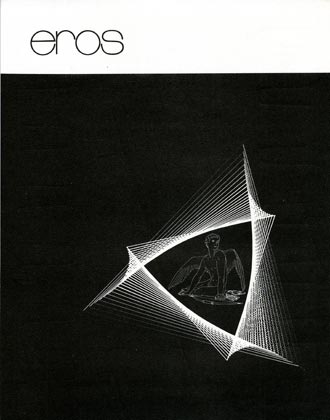
Renamed the Saskatchewan Accelerator Laboratory, the lab became a “mainstay of the [physics] department’s experimental subatomic physics research program and became an international user facility.”
1988

New building for Saskatoon Cancer Centre opened on campus.
1999

University of Saskatchewan selected to host the Canadian Light Source, Canada’s only synchrotron
2004

Prime Minister Jean Chretien opens the $174-million Canadian Light Source. Made-in-Saskatchewan design is one of the most efficient, compact and advanced in the world, and uses the linear accelerator as an injector.
2008

First images from the unique-in-North America Bio-Medical Imaging and Therapy Beamline (BMIT) at the Canadian Light Source. BMIT researchers plan work on delivery of precise beams of high energy X-rays for cancer treatment.
physorg.com/news149256035.html
“I’m particularly proud of the bone work we’ve done, seeing how the contrast we see in the images relates to the bone’s internal structure. This work is leading to one of our first human applications: assessing bone strength and internal structure using DEI to understand and assess things like osteoporosis.”
– Dean Chapman, Canada Research Chair in X-Ray Imaging, in “Medical Beamline Celebrates First Year of Scientific Results”, Dec. 2009
2011

In January, 2011, the CLS at the University of Saskatchewan awarded $12 million from the federal and provincial governments to build a new linear accelerator for research into the production of isotopes for medical diagnosis and treatment. Aim is to safely, cheaply and reliably produce medical isotopes without using a nuclear reactor or weapons-grade uranium.
Premier Brad Wall announces (in March) $30 million to establish a USask research centre that will re-establish the province as an international leader in nuclear science and nuclear medicine.

The Canadian Centre for Nuclear Innovation launched in the fall of 2011 to place Saskatchewan among global leaders in nuclear research, development and training.
“This cyclotron will enable the production of the isotopes needed to provide the PET-CT program to Saskatchewan patients. This is a critical partnership that marries the science and technology of innovation with the real-time delivery of health service.”
– Saskatchewan Innovation Minister Rob Norris, at the cyclotron and PET-CT scanner funding announcement, March 4, 2011
2012
On Oct.3, Canadian Centre for Nuclear Innovation was renamed the Sylvia Fedourk Canadian Centre for Nuclear Innovation, in honour of Saskatchewan’s own cancer physicist and first female lieutenant governor, Sylvia Fedoruk, who had died on Sept. 26 of that year.
The Fedoruk Centre manages the university’s cyclotron—the Saskatchewan Centre for Cyclotron Sciences—which is used for research, training and production of specific medical isotopes for use in the province’s first PET-CT scanner for cancer treatment.”




